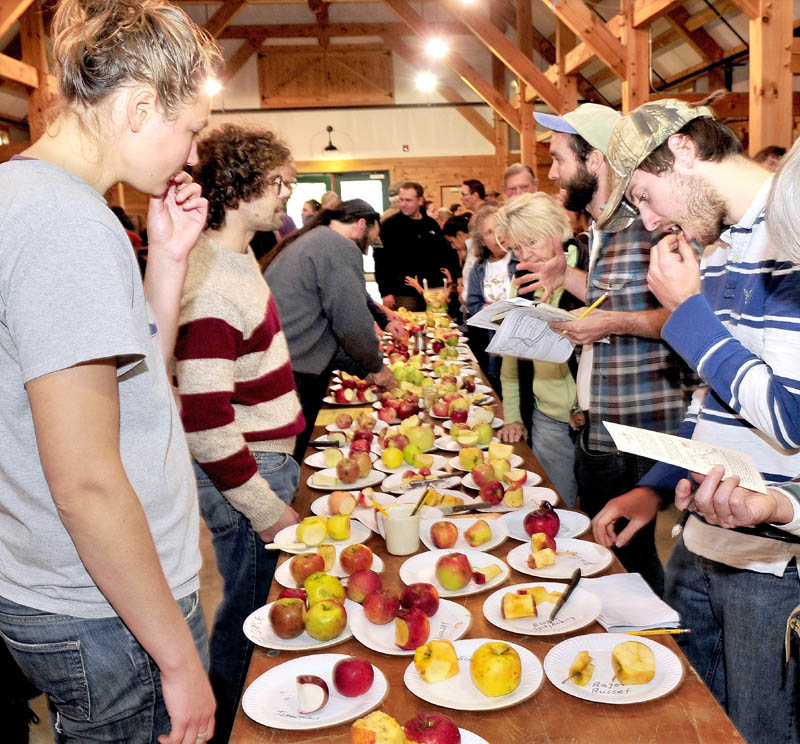UNITY — The subject of John Bunker’s decades-old search has red cheeks, a round shape and was last seen in Waldo County.
It’s an apple.
For years, Bunker has kept an eye out for the elusive Naked Limbed Greening Apple, along with two dozen other varieties that have faded into obscurity, perhaps growing quietly on a 200-year-old tree in the backyard of an unwitting Mainer.
Bunker is a pomologist. Pomology is the science and practice of growing fruit, and the 62-year-old Colby College graduate has been at it for 40 years. He has been the driving force behind an effort to find Maine’s lost varieties and nurse them back to prominence at his Palermo orchard. For the past decade, Bunker has also been the star attraction at the annual Great Maine Apple Day, which was held Sunday at the Maine Organic Farmers and Gardeners Association.
Hundreds of visitors gathered at the Common Ground Education Center to sample 70 varieties of Maine apples, learn growing techniques and seek answers from Bunker. They also learned about the missing varieties, such as the Runnels Apple that was last seen in Somerset County, the Queen’s Pocket Apple that was last seen in Hancock County and the Hoyt Sweet Apple that was last seen in Franklin and Kennebec counties.
At the center of the event was a table dedicated to stacks upon stacks of missing posters, many with “composite drawings” of apples alongside written descriptions of each one’s taste, texture and hometown. Bunker hopes visitors will distribute the posters to the regions where the apples were last seen.
The posters have proved successful — more than a half dozen lost apples have been discovered in recent years. For instance, when a woman in Marlboro learned about the missing Marlboro Apple, she picked fruit from every tree at a nearby farm, and sent them to Bunker in paper bags. Lo and behold, the Marlboro Apple was there.
Bunker drove to the farm, took a clipping, then raised a new generation of Marlboro trees and returned them to their namesake town.
“It’s been saved,” Bunker said of the variety. “They’re back in their community.”
Maine was once home to 1,000 varieties, and there were about 20,000 varieties in the eastern United States during the Civil War. Today, there are fewer than 200 varieties in Maine and very few are available to shoppers.
“Go to Hannaford’s and there are about six,” he joked.
At his orchard, Bunker has 150 varieties, and he provides those apples to customers through a subscription service called Out on a Limb CSA. The service, which follows the community-supported agriculture business model, delivers apples on a biweekly basis throughout autumn to seven markets in Maine, including Barrell’s Community Market in Waterville. For about $100, subscribers receive 20 rare varieties of apples during the course of the season, and each delivery includes a description of the apples — their history and uses.
“A lot of these apples aren’t dessert apples, like honey crisp or golden delicious. Some of these are way better if you bake them, put them in a pie or in sauce,” he said.
Thorndike farmer Matthew Woods found an apple Sunday that was particularly undessertlike. Woods sampled about 15 of 70 varieties Bunker had on display, until he sank his teeth into a Becker Apple that sent him trotting to the nearest garbage pail to spit it out.
“That one was just disgusting,” he said with a laugh.
But it was an exception. Woods said a surprising range of tastes and textures was available at the event.
“It’s astounding the differences between them,” he said.
The varieties grew out of necessity in Maine, Bunker said. Apples are among just a few cold-hardy fruits available to Northeast farmers, and they were developed for many purposes — animal feed, cider, vinegar and, of course, food in many forms — and they grew without much effort.
Tasting these forgotten varieties is like stepping into the past. While books and photographs can provide a glimpse into the mind of a long-lost writer or through the eyes of a photographer, eating an apple unique to a particular region is a sensual trip.
“When you taste one of these apples, you’re not looking at a museum piece; you’re tasting the exact same food that they ate,” he said. “This is an absolute, 100 percent direct connection with our ancestors.”
Ben McCanna — 861-9239
bmccanna@centralmaine.com
Send questions/comments to the editors.




Success. Please wait for the page to reload. If the page does not reload within 5 seconds, please refresh the page.
Enter your email and password to access comments.
Hi, to comment on stories you must . This profile is in addition to your subscription and website login.
Already have a commenting profile? .
Invalid username/password.
Please check your email to confirm and complete your registration.
Only subscribers are eligible to post comments. Please subscribe or login first for digital access. Here’s why.
Use the form below to reset your password. When you've submitted your account email, we will send an email with a reset code.